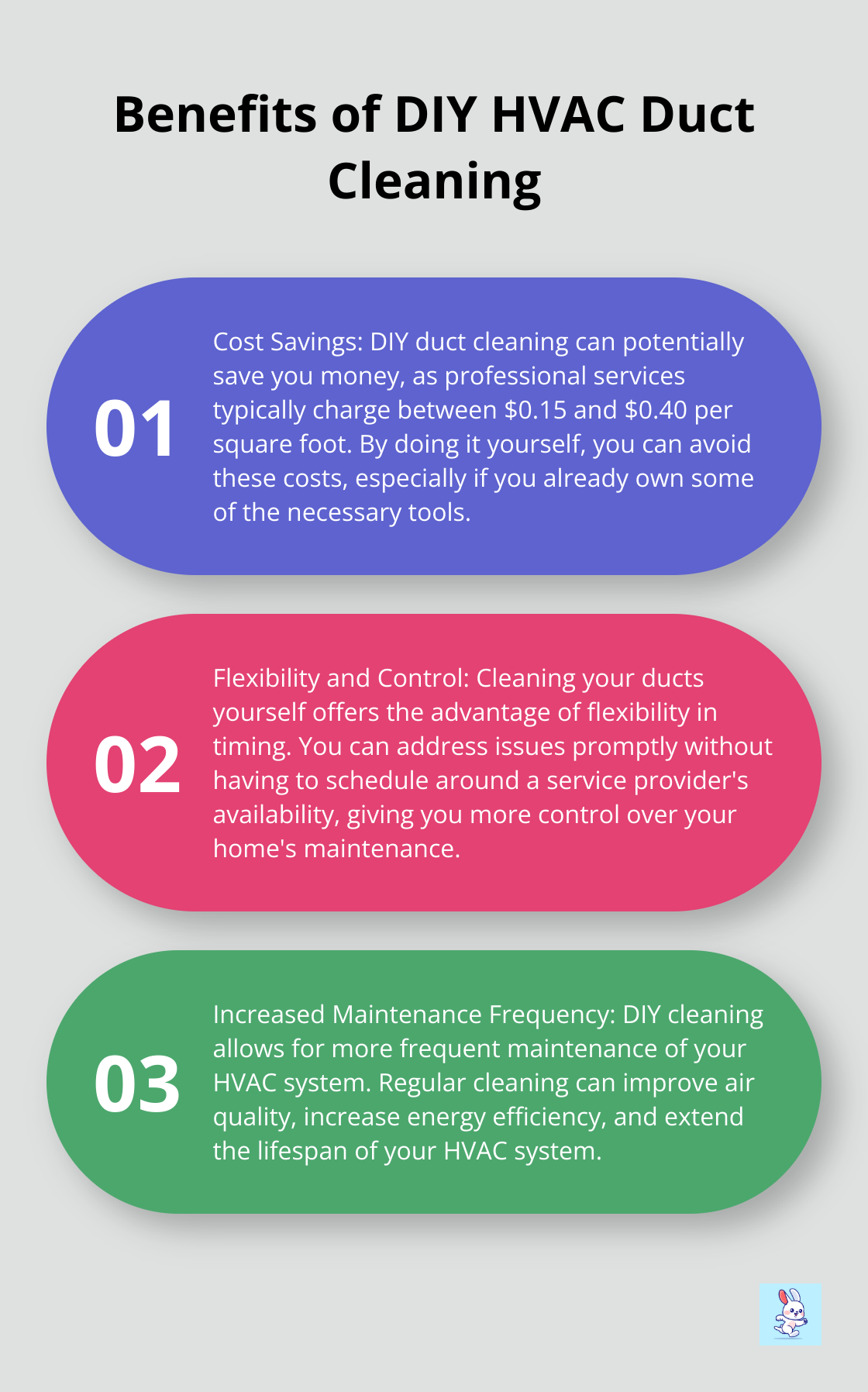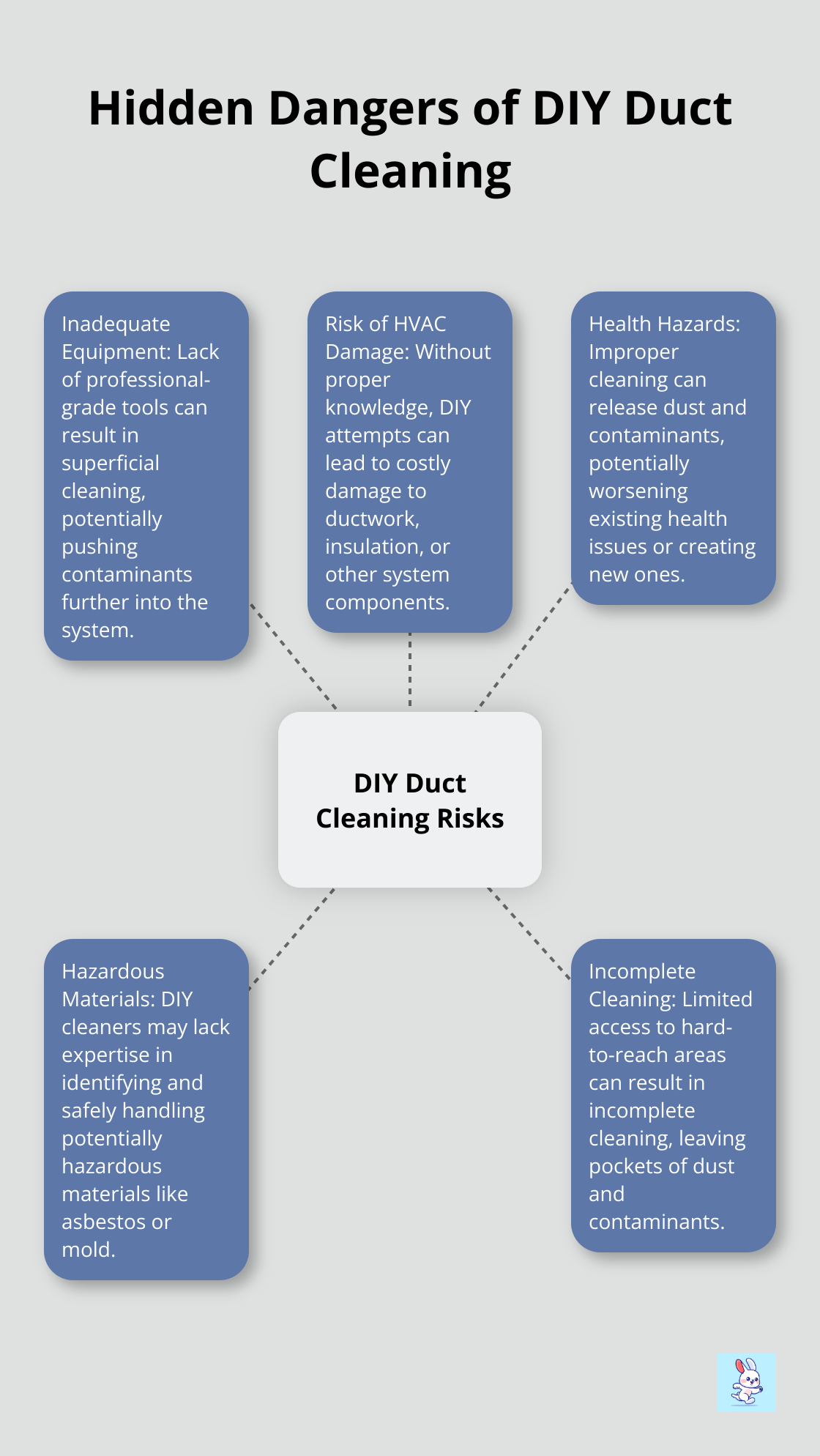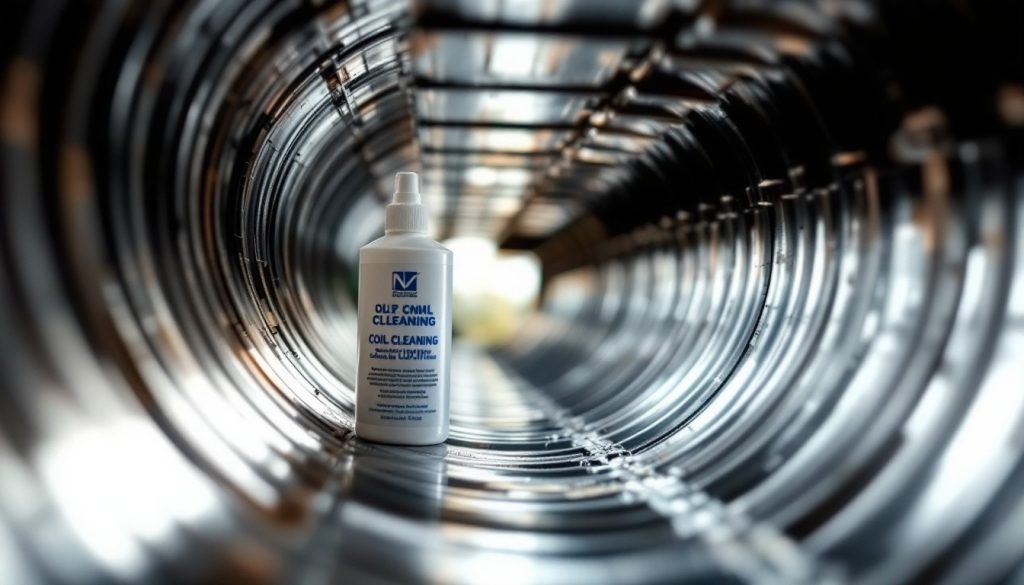At Cleaning Rabbit, we often get questions about HVAC duct cleaning. Many homeowners wonder if they can tackle this task themselves.
While DIY cleaning can save money, it’s important to consider the potential risks and challenges. This includes the need for specialized equipment and knowledge of HVAC coil cleaning solutions.
In this post, we’ll explore the pros and cons of cleaning your HVAC ducts yourself, helping you make an informed decision.
What Is HVAC Duct Cleaning?
Definition and Process
HVAC duct cleaning involves the removal of dust, debris, and contaminants from your home’s heating, ventilation, and air conditioning system. This process encompasses the cleaning of supply and return air ducts, registers, grilles, diffusers, heat exchangers, cooling coils, and air handling unit components.
The Significance of Clean Ducts
Clean ducts are essential for maintaining good indoor air quality. The EPA reports that indoor air can be 2 to 5 times more polluted than outdoor air (a concerning fact, given that Americans spend approximately 90 percent of their time indoors). Dirty ducts can circulate allergens, dust, and other particles throughout your home, which may exacerbate respiratory issues.

Recommended Cleaning Frequency
The National Air Duct Cleaners Association (NADCA) recommends getting your air ducts inspected at least once a year, and cleaned as needed. However, certain situations may necessitate more frequent cleaning:
- After home renovations or remodeling
- If you have pets that shed excessively
- When you move into a new home
- If you notice visible mold growth inside the ducts
Indicators for Duct Cleaning
Watch for these signs that indicate it’s time to clean your ducts:
- Visible dust or debris emanating from air vents
- Unexplained increases in energy bills
- Uneven airflow throughout your home
- Musty odors when the HVAC system operates
The Impact of Professional Cleaning
Professional duct cleaning can significantly improve air quality and HVAC efficiency. While DIY cleaning is an option, it’s important to understand its limitations and potential risks before deciding to tackle this job yourself.
As we explore the pros and cons of DIY HVAC duct cleaning in the next section, you’ll gain valuable insights to help you make an informed decision about whether to clean your ducts yourself or hire a professional service.
Pros of DIY HVAC Duct Cleaning
Cost Savings
DIY HVAC duct cleaning appeals to many homeowners due to potential cost savings. Professional duct cleaning services typically charge between $0.15 and $0.40 per square foot. You can save a substantial amount if you already own some of the necessary tools and decide to clean your ducts yourself.
Flexibility and Control
One of the main advantages of DIY duct cleaning is the flexibility it offers. You can clean your ducts when it’s convenient for you, without the need to schedule around a service provider’s availability. This flexibility allows you to address issues promptly, which can prevent more serious problems from developing.
Increased Maintenance Frequency
DIY cleaning enables more frequent maintenance. Regular air duct cleaning offers a plethora of benefits, including improved air quality, energy efficiency, and extended HVAC system lifespan. This regular attention can help maintain optimal air quality and system efficiency.
Understanding Your HVAC System
When you take on duct cleaning yourself, you gain valuable insights into your HVAC system. You’ll become more familiar with its components and operation, which can help with future maintenance and troubleshooting. This knowledge empowers you to make more informed decisions about your home’s air quality management.
Personal Satisfaction
Many homeowners find satisfaction in completing home maintenance tasks themselves. DIY duct cleaning can provide a sense of accomplishment and control over your home environment.

It’s important to note that DIY duct cleaning has limitations. The lack of professional-grade equipment and expertise can result in incomplete cleaning or even system damage. For thorough, safe cleaning (especially in cases of mold or severe contamination), professional services offer the expertise and equipment necessary for optimal results. In the next section, we’ll explore the potential drawbacks of DIY HVAC duct cleaning to help you make an informed decision.
The Hidden Dangers of DIY Duct Cleaning
While DIY duct cleaning may seem appealing, it comes with several hidden risks that homeowners should be aware of before attempting the task themselves.

Inadequate Equipment Compromises Results
Most homeowners don’t have access to the specialized tools required for thorough duct cleaning. Professional-grade equipment, such as a powerful, two-stage duct cleaner and vent cleaning vacuum, vacuum/brush remote control, twin HEPA cartridge filters, and clever modular design, removes deeply embedded contaminants effectively. Without these tools, DIY efforts often yield superficial cleaning at best.
The National Air Duct Cleaners Association (NADCA) stresses that proper duct cleaning requires negative air pressure and specialized brushes. Attempts to clean ducts with a household vacuum or basic brushes can push contaminants further into the system, which worsens air quality.
Risk of Costly HVAC Damage
HVAC systems are complex and delicate. Without proper knowledge, DIY cleaners might damage crucial components. Many cases exist where homeowners accidentally punctured ductwork, damaged insulation, or dislodged important connections during cleaning attempts.
A recent example involved a homeowner who tried to clean their own ducts and ended up with a $2,000 repair bill due to damaged flex ducts and a cracked heat exchanger. These repairs far exceeded the cost of professional cleaning.
Health Hazards from Improper Cleaning
DIY duct cleaning can pose health risks. However, there is no evidence that a light amount of household dust or other particulate matter in air ducts poses any risk to your health.
The EPA warns that improper cleaning can lead to the release of dust, dirt, and other contaminants throughout the home. In severe cases, this can worsen existing health issues or create new ones.
Lack of Expertise in Handling Hazardous Materials
Professional duct cleaners receive training to identify and safely handle potentially hazardous materials (such as asbestos or mold). DIY cleaners might inadvertently expose themselves and their families to these dangers without proper precautions.
Incomplete Cleaning Due to Limited Access
Many parts of an HVAC system are difficult to reach without specialized equipment. DIY attempts often miss these hard-to-access areas, leaving behind pockets of dust and contaminants that can continue to circulate through your home.
Final Thoughts
DIY HVAC duct cleaning offers potential benefits, but the risks often outweigh the rewards. The lack of proper equipment and expertise can result in incomplete cleaning, system damage, and health hazards. Professional cleaning becomes essential when dealing with visible mold growth, severe contamination, or after major home renovations.
Regular maintenance can help maintain cleaner ducts between professional cleanings. Changing air filters, keeping vents unobstructed, and scheduling annual HVAC maintenance all contribute to better air quality and system performance. You can also use HVAC coil cleaning solutions as part of your routine maintenance to keep your system running efficiently.
CleaningRabbit offers expert residential and commercial air duct cleaning services in Las Vegas and Henderson. With state-of-the-art HEPA-filtered equipment, they ensure superior air quality and a healthier home environment. Professional care combined with regular maintenance will help you enjoy cleaner air and a more efficient HVAC system for years to come.

